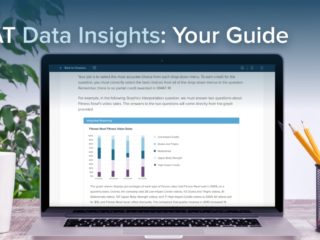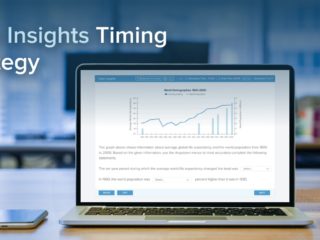| Getting your Trinity Audio player ready... |
If you’re preparing for the GMAT, knowing how to approach the Data Insights section can give you a serious edge.
Quick Answer: The Data Insights section on the GMAT evaluates your ability to interpret and synthesize data from tables, graphs, and text. Preparing effectively means understanding the format, mastering the question types, and practicing with purpose.
To prepare for GMAT Data Insights:
- Know the question types:
- Multi-Source Reasoning
- Table Analysis
- Graphics Interpretation
- Two-Part Analysis
- Data Sufficiency
- Sharpen key skills:
- Interpreting visual data
- Filtering and comparing data sets
- Drawing inferences from text + numbers
- Practice strategically:
- Use timed sets to build pacing
- Review explanations to understand logic
- Prioritize accuracy first, then speed
Continue reading to discover how each question type functions, common mistakes to avoid, and expert-backed strategies for excelling in this crucial section of the GMAT.
Here are the topics we’ll cover:
- The Data Insights Section of the GMAT
- Prepare for Data Sufficiency Questions During Your Quant Studying
- Prepare for Data Insights Questions After Quant and Verbal
- Preparing for Graphics Interpretation
- Preparing for Table Analysis
- Preparing for Two-Part Analysis
- Preparing for Multi-Source Reasoning
- What Resources Help Improve Data Insights Skills?
- Which Strategies Work Best for GMAT Data Insights Problems?
- How Important Is Data Insights on the GMAT?
- Does the GMAT Have Data Interpretation?
- In Summary: How to Effectively Prepare for GMAT Data Insights
- What’s Next?
Let’s begin our discussion of Data Insights preparation by reviewing the basics of the section.
The Data Insights Section of the GMAT
The GMAT tests MBA applicants’ math, reading, critical reasoning, and data literacy skills using 3 sections. Those 3 sections are Quantitative Reasoning, Verbal Reasoning, and Data Insights. Test takers have 45 minutes to complete each section. Additionally, each section score contributes equally to the GMAT total score.
The GMAT Data Insights section is focused on testing skill in analyzing and interpreting data to make informed decisions. It consists of 20 questions of 5 main types.
Data Sufficiency GMAT: These questions test your skill in determining the relevance and sufficiency of information. You will read a question and then evaluate 2 individual statements. Then you will determine whether the given information is sufficient for answering the question.
Graphics Interpretation: These questions present information in graphical form. They will test your skill in interpreting and using the provided information.
Table Analysis: These questions present information in tables. They test your skill in sorting the information, determining which information is relevant, and making inferences from the information.
Two-Part Analysis: These questions are quant- or verbal-based. They add additional complexity by requiring you to identify 2 correct answers, which often depend on each other.
Multi-Source Reasoning: These questions test your skill in analyzing and employing information from multiple sources.
In a given GMAT Data Insights section, about a third of the questions will be Data Sufficiency (DS) questions. Questions of the other 4 types comprise the rest of the section.
KEY FACT:
The Data Insights section tests skill in analyzing and interpreting data to make informed decisions.
Now that we understand what is in the Data Insights section, let’s discuss some GMAT Data Insights tips for preparation. We’ll start with an approach to mastering Data Sufficiency.
Prepare for Data Sufficiency Questions During Your Quant Studying
Historically, GMAT Data Sufficiency questions appeared in the Quant section of the test. So, when people prepared for the Quantitative, Verbal, and Integrated Reasoning sections of the GMAT, they studied Data Sufficiency (DS) as part of their Quant preparation.
Now, the GMAT has moved DS questions to the Data Insights section. Nevertheless, it still makes sense to prepare for DS during your Quant preparation. Here’s why.
Data Sufficiency questions can involve any of the topics that appear in Quant questions. Meanwhile, the best way to master answering Quant questions is to focus on 1 topic at a time. One effective GMAT Data Insights strategy is to practice answering DS questions during your topical learning of Quant material.
So, to master DS, as you work on each GMAT Quant topic, do DS practice questions as well. By preparing that way, you’ll master DS, and you’ll also develop even stronger Quant skills. This is because you’ll be getting extra Quant practice by answering both Data Sufficiency and Problem-Solving questions.
For more on how to prepare for Data Sufficiency, check out our article on GMAT Data Sufficiency questions.
TTP PRO TIP:
Your studying will be most efficient if you prepare for GMAT Data Sufficiency as you prepare for Quant.
Let’s move on to our next tip for Data Insights success.
Prepare for Data Insights Questions After Quant and Verbal
This next tip will save you lots of time and trouble in your quest for Data Insights score improvement. So, when you are thinking about how to prepare for Data Insights, be sure that you master Quant and Verbal before studying GMAT Data Insights question types (other than Data Sufficiency). Here’s why.
Other than DS questions, Data Insights questions include what are called Integrated Reasoning (IR) questions. The phrase Integrated Reasoning implies the simultaneous use of many types of information and analytical skills. So, in the context of the GMAT exam, Integrated Reasoning questions require using math, data analysis, and verbal skills. What this means is that GMAT Quant and Verbal preparation is, essentially, GMAT Data Insights preparation.
For example, to answer Two-Part Analysis questions, you may need to use linear equations or rates concepts from your Quant study. To answer Multi-Source Reasoning (MSR) questions, you may need to use Critical Reasoning or Reading Comprehension strategies from your Verbal study. These and other concepts and strategies that you’ll need for IR-style questions are all things you learn during your Quant and Verbal prep.
TTP PRO TIP:
Prepare for Quant and Verbal before studying GMAT Data Insights question types (with the exception of Data Sufficiency).
So, you can see that preparing for Quant and Verbal before IR-style questions makes mastering Data Insights on GMAT exams much easier and faster.
Study Graphics Interpretation and Table Analysis Before Multi-Source Reasoning
When you do reach the phase of your studies in which you’re learning how to tackle IR-style questions, it’s wise to study Graphics Interpretation and Table Analysis before Multi-Source Reasoning. This sequence works best because Multi-Source Reasoning prompts often include graphs or tables. So, by studying Graphics Interpretation and Table Analysis before Multi-Source Reasoning, you’ll develop skills you’ll use for Multi-Source Reasoning as well.
TTP PRO TIP:
For best results from your Data Insights preparation, study Graphics Interpretation and Table Analysis before Multi-Source Reasoning.
Let’s now talk a bit about studying each of the Data Insights Integrated Reasoning question types.
Preparing for Graphics Interpretation
Graphics Interpretation (GI) prep involves 3 main tasks. The first is to learn to read the various types of graphs that appear in GI questions. The second is to learn strategies for answering GI questions. Of course, the last is to practice GI to learn to answer the questions efficiently and correctly.
In most cases, the types of graphs that appear in Graphics Interpretation questions will be quite familiar to you. Nonetheless, by going over all the types of graphs in advance and practicing reading them, you’ll be much quicker on test day. And of course, learning the ins and outs of answering GI questions will help you maximize your score.
One key caveat about the graphs in Data Insights is that they aren’t always very easy to read. The question writers sometimes make the graphs challenging to read, or they use confusing wording in labels. So, it’s good to gain practice in careful reading of the graphs, so that you don’t miss questions by misreading. Also, keep in mind that you have the option to use a GMAT Data Insights calculator if you are faced with any messy calculations.
TTP PRO TIP:
A key aspect of effective Graphics Interpretation prep is learning how different types of graphs work and how to read them.
Preparing for Table Analysis
The skills you need to develop for Table Analysis (TA) are twofold. First, you need skill in sorting the tables optimally. Second, you need skill in determining what data is relevant for answering a particular question. A good GMAT prep resource, such as the Target Test Prep GMAT Course, will help you develop these skills quickly by solving many GMAT Data Insights examples.
Table Analysis questions can involve Quant topics, such as averages or rates. TA questions might also involve making inferences, as in Verbal questions. So, once you’ve developed the general TA skills, mastering TA is mostly a matter of learning to use tables to answer various types of quant- and verbal-based questions.
TTP PRO TIP:
The main skills you need to develop for Table Analysis are sorting the tables optimally and determining what data is relevant.
Preparing for Two-Part Analysis
Two-Part Analysis (TPA) questions are basically GMAT Quant and Verbal questions with 2 answers instead of 1. So, your main task in preparing for Data Insights TPA questions is to learn strategies for dealing with 2 often-related answers.
One key strategy you’ll need to master is identifying answers by determining which choices work together. You’ll need to learn this because, in some TPA questions, more than 2 choices work individually. In such cases, the only way to choose 2 answers is to determine which choices are the only 2 that work with each other.
In addition, there are some TPA question types, such as Complete the Statement, that you won’t have seen in your Quant or Verbal prep. So, it’s important to learn about these types of questions, so that you’re ready for them on test day. Once you’ve learned how these types of questions work, practice with plenty of TPA Data Insights practice questions to develop skill in answering them.
TTP PRO TIP:
Your main task in preparing for Data Insights Two-Part Analysis questions is to learn strategies for dealing with 2 answers.
Preparing for Multi-Source Reasoning
As we’ve discussed, Multi-Source Reasoning (MSR) requires you to use various types of information to answer the questions. So, your main task in preparing for MSR is learning to use various types of information from different sources together.
The information in MSR questions appears on 2 or 3 tabs in the prompt. Accordingly, to master MSR, you’ll need to develop skill in the following:
- knowing what type of information is on each tab
- using keywords to locate information in the prompt
- telling the difference between relevant and irrelevant information and finding the information you need without getting distracted by other information
- answering math questions using formulas, procedures, or values found in the prompt or question stem
- working step by step to execute well
TTP PRO TIP:
Your main task in preparing for Multi-Source Reasoning is learning to use various types of information from different sources together.
Let’s now answer some common questions related to GMAT Data Insights prep.
What Resources Help Improve Data Insights Skills?
The best resources for improving Data Insights skills are those that include comprehensive explanations of the concepts and strategies you need for Data Insights. In addition, your resources should include plenty of practice questions with answer explanations you can learn from.
One such resource is the Target Test Prep GMAT Course. The Quant section of the course includes Data Sufficiency prep. Then, the Data Insights section of the course has a chapter covering each of the other 4 types of Data Insights questions. Also, the course includes plenty of GMAT Data Insights sample problems for developing strong skills.
Which Strategies Work Best for GMAT Data Insights Problems?
The best GMAT Data insights strategies are generally the same ones we use to answer GMAT Quant and Verbal questions. For example, the strategies for answering ratio and weighted average questions in GMAT Quant and the strategies for eliminating answer choices in GMAT Verbal apply in Data Insights as well.
At the same time, there are some other strategies that we should learn for Data Insights. One strategy includes reviewing graphs, tables, and other information before reading the question. Another focuses on sorting tables to group relevant information. Additional strategies include testing answer choices in Two-Part Analysis questions and checking constraints step by step in Multi-Source Reasoning. By using a good GMAT prep resource and practicing effectively, you can learn these key strategies and more.
How Important Is Data Insights on the GMAT?
On the GMAT, Data Insights (DI) is 1 of 3 equally weighted GMAT sections. So, your performance on Data Insights accounts for one-third of your total GMAT score. Previously, DI’s predecessor — Integrated Reasoning (IR) — was separately scored and was not included as part of the GMAT Total Score. Students generally considered it a bit of a nuisance, and they spent the bulk of their study time on Quant and Verbal prep.
Now, however, DI has risen to being part of the GMAT scoring triumvirate. This is no fluke. More and more, data interpretation and analysis are playing a major role in business decision-making. As a result, understanding and interpreting both verbal and quantitative data are considered mandatory in every aspect of the business world. Data Insights questions test you on the skills you will need to use every day in your business life.
Does the GMAT Have Data Interpretation?
There are many questions on the GMAT that one would describe as “data interpretation” questions. Most of these questions appear on the GMAT in the Data Insights section.
Let’s now wrap up by summarizing what we’ve discussed.
In Summary: How to Effectively Prepare for GMAT Data Insights
Here is what we’ve seen concerning GMAT Data insights preparation:
- GMAT Data Insights tests skill in analyzing and interpreting data to make informed decisions.
- There are 5 Data Insights question types: Data Sufficiency, Graphics Interpretation, Table Analysis, Two-Part Analysis, and Multi-Source Reasoning.
- It’s most efficient to prepare for Data Sufficiency during your GMAT Quant prep.
- Preparing for Quant and Verbal before Data Insights questions, other than Data Sufficiency, can save you time and trouble.
- It works best to prepare for Graphics Interpretation and Table Analysis before Multi-Source Reasoning.
- In general, to prepare for GMAT Data Insights, learn how to use the various types of information involved in the questions and practice to develop accuracy and efficiency.
What’s Next?
Now that you know how to prepare for Data Insights, you can learn how to prepare for the other GMAT sections from our post on GMAT Quant preparation and our post on how to score high on GMAT Verbal.
To learn more about the Data Insights section, read our article about GMAT Data Insights timing strategy and our GMAT Data Insights guide.



